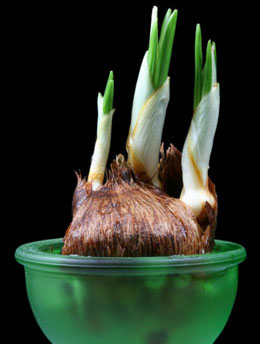Crocus bulbs are actually not true bulbs, but corms. These corms are used to grow crocus plants, which are known for their small and attractive flowers that bloom quite early in spring. Find out more information about crocus plants, and how to grow and care for them, in this Buzzle write-up.

Crocus is a genus of perennial flowering plants which belong to the family,
Iridaceae. The crocus plant grows from the corm, which is usually called the crocus bulb. The small and beautiful crocus flowers are one of the few flowers to announce the arrival of the spring. The flowers appear at the end of the winter by pushing through the snow, which is a really beautiful sight to behold.
The crocus flowers can look particularly striking in a lawn, especially when they are grown in masses. This flowering plant is native to Central Asia, China, Middle East, and coastal and subalpine regions of Central and Southern Europe. The word crocus is actually derived from the Greek word for 'saffron'.
Planting Crocus Plants
The crocus bulb is actually a bulb-shaped corm, and is one of the easiest corms to grow in late winter or early spring. The corm can be found with a very thin paper-like outer covering, which is known as tunic. As the plant grows, the corm becomes smaller and then eventually fades away. But at the end of the growing season when the plant goes dormant, a new bulb is formed, from which a new plant sprouts in early spring. A single crocus corm can produce multiple flowers.
The crocus plant is a very small plant that grows up to a height of about 3 to 6 inches, with grass-like narrow foliage with a silver-gray central stripe. The plant produces cup- or calyx-shaped flowers that come in an array of colors, ranging from white, golden, and yellow, to light pink, lilac, mauve, and deep purple. The beautiful crocus blossoms bloom from late winter to early spring. The most interesting feature of the crocus flowers is that they bloom or open up only when there is a lot of sunlight.
The Right Time
Crocuses usually bloom either in autumn or spring. The spring-blooming crocus corms are usually planted in autumn or fall. In colder climates, they should be planted early in Autumn. On the other hand, the fall-blooming crocus bulbs are usually planted in spring.
The Right Method
First of all, select a good quality or healthy corm without any soft or rotting spot. The crocus plant needs a lot of sunlight to thrive, and its beautiful blossoms open up only when there is a lot of sunlight. So, choose a sunny location for planting the corm.
The plant usually prefers sandy and well-drained soil. To plant the corms, dig 3 to 4 inches deep holes, and be sure to maintain a space of about 2 to 3 inches between two corms. While planting, place the corms in such a way that their bottoms are positioned firmly at the bottom of the holes. After planting, water the corms thoroughly.
Maintenance
A place that receives direct sunlight throughout the day is the ideal place for planting crocus corms. You can apply a fertilizer, or spread a layer of organic compost on the selected area before planting the corms. After planting the corms, you can spread a layer of mulch over them.
Do not forget to water the corms at regular intervals, preferably once in a week. Later on, when the seedlings appear, you can reduce the frequency of watering. In winter, i.e., in the dormant season, watering is not required. As far as fertilization is concerned, you can add a slow-release bulb fertilizer once in a year, just at the end of the flowering season.
The crocus is a very beautiful plant to have in any lawn, woodland, and ornamental flower garden. The delicate and attractive crocus blossoms with their bright and striking colors, can give your garden or lawn a truly warm and fascinating look. Besides, the corms are quite easy to grow and require only minimal care and maintenance. The flowers can look amazing with other spring-blooming plants, and under the shade of a deciduous shrub or tree, provided it is not an evergreen tree. If grown under an evergreen tree, crocus plants would not receive the amount of sunlight they need during spring.






 Crocus is a genus of perennial flowering plants which belong to the family, Iridaceae. The crocus plant grows from the corm, which is usually called the crocus bulb. The small and beautiful crocus flowers are one of the few flowers to announce the arrival of the spring. The flowers appear at the end of the winter by pushing through the snow, which is a really beautiful sight to behold.
Crocus is a genus of perennial flowering plants which belong to the family, Iridaceae. The crocus plant grows from the corm, which is usually called the crocus bulb. The small and beautiful crocus flowers are one of the few flowers to announce the arrival of the spring. The flowers appear at the end of the winter by pushing through the snow, which is a really beautiful sight to behold.